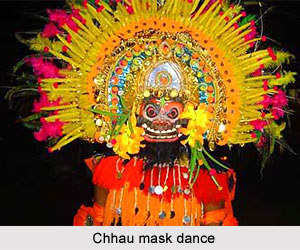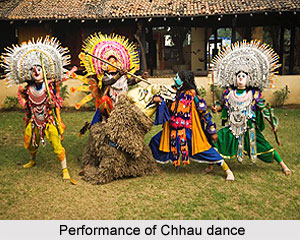 Chhau dance of Purulia is an open air dance and the techniques have developed in accordance with and on the basis of this tradition. The performance is held on the ground. An open area of about 20 ft. in length and 20` ft. in breadth is enough but a corridor of not less than about 5 ft in breadth must be maintained for entrance and exit of performers. The corridor becomes a part of the performing area.
Chhau dance of Purulia is an open air dance and the techniques have developed in accordance with and on the basis of this tradition. The performance is held on the ground. An open area of about 20 ft. in length and 20` ft. in breadth is enough but a corridor of not less than about 5 ft in breadth must be maintained for entrance and exit of performers. The corridor becomes a part of the performing area.
The dancing enclosure is circular. All the musicians sit together on one side with their musical instruments kept at one place. Each party has its own group of musicians numbering. When different groups participate each group plays for its own party only, while other groups sit idle. The musicians for one particular party will not play for dances of the other party as the dances are presented after prolonged rehearsals with the musicians of the concerned parties. There is no decoration for the dancing enclosure.
The last item, which is the killing of Ravana by Lord Rama, must be performed before it comes to an end. In the beginning of the performance the musicians of the performing parties appear on the dancing enclosure party wise and display of their talent for a period of lime. The two drummers dance as they play on their instruments at times reciting the stroke sounds of the music vocally. After this the vocalist appears in the enclosure with folded palms and sings a brief invocation to Lord Ganesha. While the song is sung the instrumental music is stopped for a short while and as soon as the vocalist stops, the drummers begin to beat the drums loudly. The music for the night`s performance starts.
 Immediately Ganesha appears at the farthest distance of the corridor for entrance. He takes a long pause spreading his two natural hands on his two sides. He has four hands, two of which are made of wood and adjusted from his back. These are raised upwards and are naturally stationary. After Ganesha`s entrance the theme takes a dramatic turn with the arrival of a new character. It reaches its climax and its fast moving incidents add to the excitement. Sound of music heightens. The theme reaches its climax at the middle of the dance, it falls at the end, and, the scene is closed after reconciliation between the fighting parties.
Immediately Ganesha appears at the farthest distance of the corridor for entrance. He takes a long pause spreading his two natural hands on his two sides. He has four hands, two of which are made of wood and adjusted from his back. These are raised upwards and are naturally stationary. After Ganesha`s entrance the theme takes a dramatic turn with the arrival of a new character. It reaches its climax and its fast moving incidents add to the excitement. Sound of music heightens. The theme reaches its climax at the middle of the dance, it falls at the end, and, the scene is closed after reconciliation between the fighting parties.
During the dance the vocalist goes on repeating two lines by which he introduced the first item at the very beginning of the dance. He moves around the enclosure and repeats the two introductory lines giving the audience an idea about the theme of the scene. This is done throughout the performance in every scene. However as the vocal music is not audible and impressive, the practice of repeating it throughout the dance has been abandoned by most of the parties now-a-days. Each scene is introduced by a vocalist with a very brief song sung in folk style.
Each following scene is introduced by the same vocalist. When a scene is introduced no instrumental music is played. However after the dance starts the instrumental music does not stop until it comes to an end. Introductory verses are sometimes described in two lines only.
The dance arena is flooded by a strong light. Lights are carried by persons on their heads and they move along with the movement of the dancers. The light reflects against the decorations of the crowns of the masks and adds glamour to the performance. The music stops as soon as the scene ends. The musicians relax for about a quarter of an hour till the next scene begins. However if there are two or more competing parties, Ganesha of the immediately appears at the end of the entrance of the corridor.
Each dancer carries one piece of handkerchief in each of his hands in the course of the dance irrespective of the item he performs. Now-a-days, due to theatrical influence which is occasionally held in the rural areas, the dancers have learnt to hold relevant articles like swords, shields, bows and arrows in their hands instead of two pieces of handkerchiefs.
The animal characters are realistically represented as per actions and movements are concerned. They are represented by human beings. They occupy a major position in the performance. The animals also play main roles in the scenes. The performance ends with the end of the theme which signifies victory of the good over the evil, of the gods over the devils. However due to pressure of extra-ordinary circumstances the performance can be concluded at an earlier stage.



















